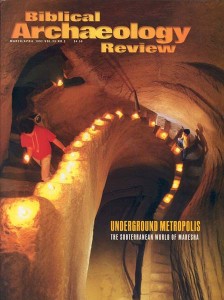Edomite Wedding Vows
Sidebar to: Underground Metropolis: The Subterranean World of Maresha
In the sunny month of June, in 176 B.C.E., members of two of Maresha’s rich Edomite families celebrated their marriage. The details of the wedding between QWSRM and his bride, Arsinoe, survive on the oldest marriage contract ever discovered in the Holy Land.1
Archaeologists at Maresha found seven fragments of the document (photo, right; translation, lower right)—written on a sherd of a pottery jug—among fill that had apparently been dumped into a cave following the destruction of the city by the Hasmoneans in 112 B.C.E.
It may seem odd to find a marriage contract written on a broken piece of pottery—especially when such wealthy families are involved. The bride’s substantial dowry, worth 300
Already a library member? Log in here.
Institution user? Log in with your IP address.

